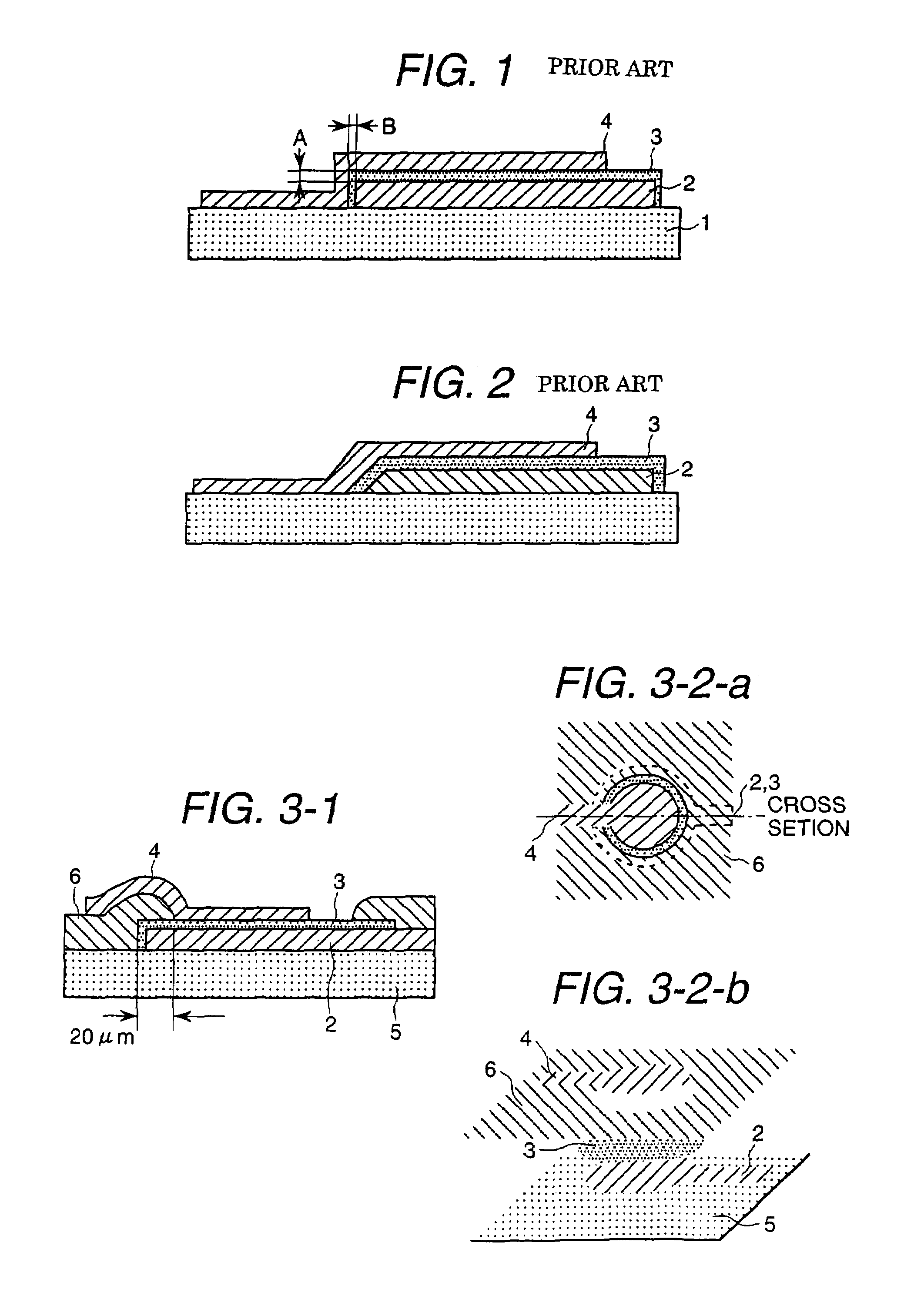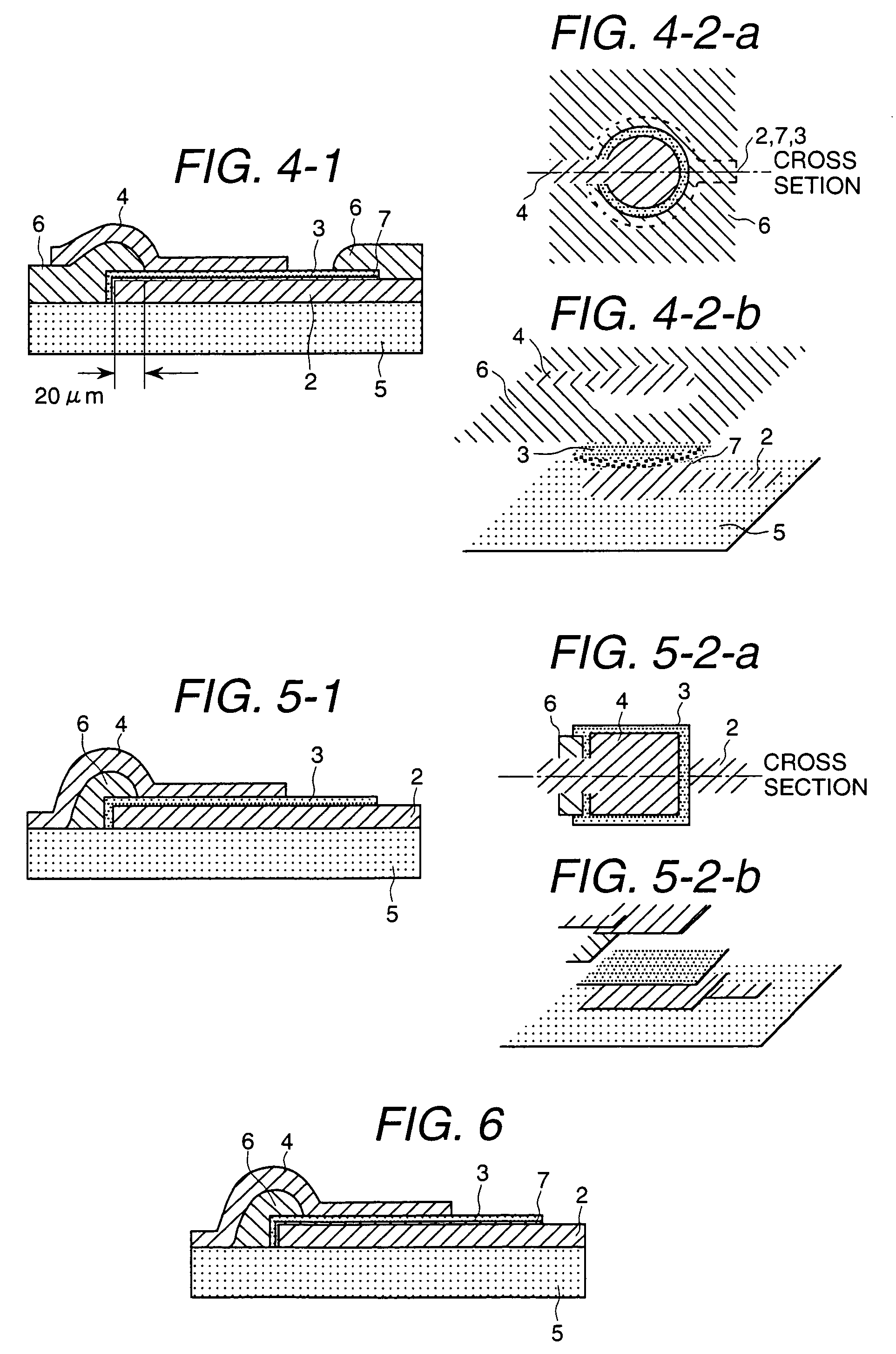Thin film capacitor and electronic circuit component
a technology of electronic circuit components and thin film capacitors, which is applied in the incorporation of printed capacitors, transistors, printed electric components, etc., can solve the problems of reducing the dielectric breakdown voltage and the likely event of shorting between the electrodes, so as to prevent the reduction of dielectric strength or shorting, improve the yield of capacitors, and enhance the accuracy of capacitors
- Summary
- Abstract
- Description
- Claims
- Application Information
AI Technical Summary
Benefits of technology
Problems solved by technology
Method used
Image
Examples
embodiment 1
[0041]FIG. 3-1 is a cross sectional view of a thin film capacitor representing an embodiment of the present invention. FIG. 3-2-a is a plan view of the thin film capacitor of the present embodiment. FIG. 3-2-b is an exploded view of the thin film capacitor of the present embodiment. Further, FIG. 3-1 is the cross sectional view taken along the cross sectional plan indicated in FIG. 3-2-a.
[0042]The thin film capacitor was produced in the following manner.
[0043]Platinum film of 2 μm was formed on a glass substrate 5 by sputtering method. Subsequently, positive type liquid resist OFPR800, 500 cp(product of Tokyo Ohka) is coated and after performing drying, exposing and developing process, a resist mask for a lower electrode was formed. Then, dry etching was performed by ion milling to remove unnecessary platinum portions and after removing the resist mask the lower electrode 2 was formed. In the present embodiment, the shape of the lower electrode is formed in a circle as shown in FIG...
embodiment 2
[0048]In the like manner as in embodiment 1 thin film capacitors were produced. In this instance, benzocyclo butene resin cycloten 4026(product of Dow Chemical) was spin coated to form the insulator and after prebaking the same through the exposing and developing process, like embodiment 1 the opening end portion of the benzocyclo butene resin was formed to locate at the inner side of the lower electrode end portion by 20 μm. The resin was hardened at 250° C. / 1 hour under nitrogen atmosphere and an insulator of 10 μm was formed.
[0049]A current feed check was performed for 20 pieces of the thin film capacitors produced according to the above method. The result thereof is shown in FIG. 10. Although the defective rate of comparison thin film capacitors was 14 / 20, the defective rate of the present embodiment was 0 / 20.
embodiment 3
[0050]Thin film capacitors were produced in a like manner as in embodiment 1. In this instance, the thin film capacitors were produced by making use of a material having low dielectric loss tangent, which was prepared in the following method as the insulator.
[0051]Three raw materials of synthesized 1,2-bis(vinylphenyl)ethane of 30 weight parts, cyclic polyolefin Zeonex 480(product of Nihon Zeon) of 70 weight parts and hardening catalyst perhexyne 25B of 0.3 weight parts were resolved in xylene solvent so that solid component assumes 38% to produce a varnish.
[0052]The varnish was spin coated and the varnish was step cured on a hot plate in 120° C. / 2 minutes and then 200° C. / 5 minutes to form an insulator of 10 μm. On the cured varnish positive type liquid resist OFPR 800,500 cp was spin coated and after drying the same, through exposing and developing process a resist mask was formed in such a manner that the opening end portion thereof locates at the inner side of the lower electrod...
PUM
| Property | Measurement | Unit |
|---|---|---|
| thickness | aaaaa | aaaaa |
| thickness | aaaaa | aaaaa |
| thickness | aaaaa | aaaaa |
Abstract
Description
Claims
Application Information
 Login to View More
Login to View More - R&D
- Intellectual Property
- Life Sciences
- Materials
- Tech Scout
- Unparalleled Data Quality
- Higher Quality Content
- 60% Fewer Hallucinations
Browse by: Latest US Patents, China's latest patents, Technical Efficacy Thesaurus, Application Domain, Technology Topic, Popular Technical Reports.
© 2025 PatSnap. All rights reserved.Legal|Privacy policy|Modern Slavery Act Transparency Statement|Sitemap|About US| Contact US: help@patsnap.com



